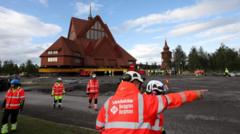The iconic Kiruna Church, a stunning 113-year-old timber structure at risk from ground subsidence, has begun a momentous journey across the Swedish city of Kiruna. Starting early Tuesday morning, the church is being relocated a distance of 5 kilometers (3 miles) to a newly planned city center. This massive move comes as the original city experiences fissures and instability due to over a century of mining for iron ore in the region.
Engineered to perfection, the historic church, which stands at 35 meters (115 feet) high and 40 meters wide, is being transported on giant rolling platforms with a maximum speed of 500 meters per hour. The two-day journey makes use of self-propelled modular transporters, reflecting both the intricate planning and advanced technology involved in this unique operation.
Project manager Stefan Holmblad Johansson stated, “It’s a historic event, a very big and complex operation,” emphasizing the meticulous preparations that have taken place to ensure a successful transfer without damaging the structure or its valuable interior. Celebrated as Sweden's most beautiful pre-1950 building, Kiruna Church has been integral to the community since 1912, serving as a spiritual sanctuary and gathering point for generations.
As part of the gradual urban relocation prompted by mining operations, several other landmarks have already been either moved or replaced. Over the years, as sinkholes have threatened infrastructure, the local government has made efforts to ensure the safety of residents by relocating essential buildings. The project is primarily funded by LKAB, the iron ore mine's operator and the largest employer in Kiruna, with an estimated cost of over 10 billion Swedish krona ($1 billion).
The move is not without its emotional weight for the community. Sofia Lagerlöf Määttä, a culture strategist in Kiruna, expressed the gravity of the moment, saying, "We've been waiting for so many years." Onlookers, including the King of Sweden, are expected to line the route, many reflecting on the memories the church holds and the role it plays in the fabric of their lives.
As the church inches forward, it transcends a mere physical relocation; it embodies the essence of community and resilience. Vicar Lena Tjärnberg acknowledged the bittersweet nature of the occasion, stating, “I’m grateful that we’re moving the church with us, but there is also sorrow in seeing it leave the ground where it became a church.”
In an age of rapid changes, Kiruna Church’s journey offers a poignant reminder of heritage, connection, and the shared history that shapes the future—the church itself moves as a living testament to the legacy of its past. The remarkable operation will also be broadcast live by Swedish television, marking a celebration of both engineering accomplishment and community spirit.
Engineered to perfection, the historic church, which stands at 35 meters (115 feet) high and 40 meters wide, is being transported on giant rolling platforms with a maximum speed of 500 meters per hour. The two-day journey makes use of self-propelled modular transporters, reflecting both the intricate planning and advanced technology involved in this unique operation.
Project manager Stefan Holmblad Johansson stated, “It’s a historic event, a very big and complex operation,” emphasizing the meticulous preparations that have taken place to ensure a successful transfer without damaging the structure or its valuable interior. Celebrated as Sweden's most beautiful pre-1950 building, Kiruna Church has been integral to the community since 1912, serving as a spiritual sanctuary and gathering point for generations.
As part of the gradual urban relocation prompted by mining operations, several other landmarks have already been either moved or replaced. Over the years, as sinkholes have threatened infrastructure, the local government has made efforts to ensure the safety of residents by relocating essential buildings. The project is primarily funded by LKAB, the iron ore mine's operator and the largest employer in Kiruna, with an estimated cost of over 10 billion Swedish krona ($1 billion).
The move is not without its emotional weight for the community. Sofia Lagerlöf Määttä, a culture strategist in Kiruna, expressed the gravity of the moment, saying, "We've been waiting for so many years." Onlookers, including the King of Sweden, are expected to line the route, many reflecting on the memories the church holds and the role it plays in the fabric of their lives.
As the church inches forward, it transcends a mere physical relocation; it embodies the essence of community and resilience. Vicar Lena Tjärnberg acknowledged the bittersweet nature of the occasion, stating, “I’m grateful that we’re moving the church with us, but there is also sorrow in seeing it leave the ground where it became a church.”
In an age of rapid changes, Kiruna Church’s journey offers a poignant reminder of heritage, connection, and the shared history that shapes the future—the church itself moves as a living testament to the legacy of its past. The remarkable operation will also be broadcast live by Swedish television, marking a celebration of both engineering accomplishment and community spirit.






















